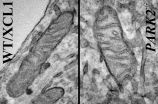(Press-News.org) A pair of images of a young star, made 18 years apart, has revealed a dramatic difference that is providing astronomers with a unique, "real-time" look at how massive stars develop in the earliest stages of their formation.
The astronomers used the National Science Foundation's Karl G. Jansky Very Large Array (VLA) to study a massive young star called W75N(B)-VLA 2, some 4200 light-years from Earth. They compared an image made in 2014 with an earlier VLA image from 1996.
"The comparison is remarkable," said Carlos Carrasco-Gonzalez of the Center of Radioastronomy and Astrophysics of the National Autonomous University of Mexico, leader of the research team. The 1996 image shows a compact region of a hot, ionized wind ejected from the young star. The 2014 image shows that ejected wind deformed into an distinctly elongated outflow.
"We're seeing this dramatic change in real time, so this object is providing us an exciting opportunity to watch over the next few years as a very young star goes through the early stages of its formation," Carrasco-Gonzalez said.
The scientists believe the young star is forming in a dense, gaseous environment, and is surrounded by a doughnut-shaped, dusty torus. The star has episodes in which it ejects a hot, ionized wind for several years. At first, that wind can expand in all directions, and so forms a spherical shell around the star. Later, the wind hits the dusty torus, which slows it. Wind expanding outward along the poles of the torus, where there is less resistance, moves more quickly, resulting in an elongated shape for the outflow.
"In the span of only 18 years, we've seen exactly what we predicted," Carrasco-Gonzalez said.
There are theoretical models developed to explain why nearly-spherical expansion of such outflows had been seen with young stars much more massive than the Sun, when narrower, beam-like outflows were expected based on observations of less-massive, Sun-like stars at similar stages of development. W75N(B)-VLA 2 is estimated to be about 8 times more massive than the Sun. The more-uniform outflows are seen in massive young stars in the first few thousand years of their lives, the stage at which W75N(B)-VLA 2 is thought to be.
"Our understanding of how massive young stars develop is much less complete than our understanding of how Sun-like stars develop," Carrasco-Gonzalez said. "It's going to be really great to be able to watch one as it changes. We expect to learn a lot from this object," he added.
INFORMATION:
Carrasco-Gonzalez worked with an international team of astronomers from Mexico, the Netherlands, Sweden, Spain, Korea, and Japan. The scientists reported their discovery in the journal Science.
The National Radio Astronomy Observatory is a facility of the National Science Foundation, operated under cooperative agreement by Associated Universities, Inc.
A new model for HIV progression finds that it spreads in a similar way to some computer worms and predicts that early treatment is key to staving off AIDS.
HIV specialists and network security experts at UCL noticed that the spread of HIV through the body using two methods - via the bloodstream and directly between cells - was similar to how some computer worms spread through both the internet and local networks respectively to infect as many computers as possible. They worked together to create a model for this 'hybrid spreading', which accurately predicted patients' ...
CAMBRIDGE, Mass. (April 2, 2015) - A team of Whitehead Institute scientists has discovered that during division, stem cells distinguish between old and young mitochondria and allocate them disproportionately between daughter cells. As a result, the daughter cell destined to remain a stem cell receives predominantly young mitochondria, while the cell meant to differentiate into another cell type carries with it a higher compliment of the aged organelles.
This asymmetric apportioning of cellular contents may represent a mechanism through which stem cells prevent the accumulation ...
Characteristics passed between generations are not decided solely by DNA, but can be brought about by other material in cells, new research shows.
Scientists studied proteins found in cells, known as histones, which are not part of the genetic code, but act as spools around which DNA is wound. Histones are known to control whether or not genes are switched on.
Researchers found that naturally occurring changes to these proteins, which affect how they control genes, can be sustained from one generation to the next and so influence which traits are passed on.
The finding ...
Variations in the color of grapevine berries within the Pinot family result from naturally-occurring genetic mutations that selectively shut down the genes responsible for the synthesis of red pigments, called anthocyanins. This has led to the emergence of Pinot blanc and Pinot gris from Pinot noir. Frédérique Pelsy and her colleagues, from the "Grapevine Health and Wine Quality" research unit at INRA Colmar, France, published these findings in PLOS Genetics on 2 April 2015.
The vine stocks used in viticulture are obtained by grafting; therefore, for any given ...
Infants have innate knowledge about the world and when their expectations are defied, they learn best, researchers at Johns Hopkins University found.
In a paper to be published April 3 in the journal Science, cognitive psychologists Aimee E. Stahl and Lisa Feigenson demonstrate for the first time that babies learn new things by leveraging the core information they are born with. When something surprises a baby, like an object not behaving the way a baby expects it to, the baby not only focuses on that object, but ultimately learns more about it than from a similar yet ...
French physicist Jean Charles Athanase Peltier discovered a key concept necessary for thermoelectric (TE) temperature control in 1834. His findings were so significant, TE devices are now commonly referred to Peltier devices. Since his work, there have been steady advancements in materials and design. Despite the technological sophistication Peltier devices, they are still less energy efficient than traditional compressor/evaporation cooling.
In the 1960's, Peltier devices were primarily made from Bismuth-Telluride (Bi2Te3) or Antimony-Telluride (Sb2Te3) alloys and ...
MIAMI - A first-of-its-kind study observed how oil droplets are formed and measured their size under high pressure. They further simulated how the atomized oil spewing from the Macondo well reached the ocean's surface during the Deepwater Horizon accident. The findings from the University of Miami (UM) Rosenstiel School of Marine and Atmospheric Science and University of Western Australia research team suggest that the physical properties in deep water create a natural dispersion mechanism for oil droplets that generates a similar effect to the application of chemical ...
Binge-drinking during adolescence may perturb brain development at a critical time and leave lasting effects on genes and behavior that persist into adulthood.
The findings, by researchers at the University of Illinois at Chicago College of Medicine using an animal model, are reported online in the journal Neurobiology of Disease.
"This may be the mechanism through which adolescent binge-drinking increases the risk for psychiatric disorders, including alcoholism, in adulthood," says lead author Subhash Pandey, professor of psychiatry and director of neuroscience alcoholism ...
Irvine, Calif. -- A newly developed website provides parents and children with individualized information and support -- based on factors like coping style and levels of worry and fear -- to help lower anxiety before outpatient surgery in children, according to a pair of articles in the April issue of Anesthesia & Analgesia.
The papers report on the development of the "Web-based Tailored Intervention Preparation for Surgery" (WebTIPS) project, which provides information and strategies to help children and parents prepare for surgery and anesthesia. A preliminary evaluation ...
Based on research in fruit flies, it has long been suspected that the most common mutation linked to both sporadic and familial Parkinson's disease (PD) wreaks its havoc by altering the function of mitochondria in neurons that produce the neurotransmitter dopamine. Using stem cells derived from patients who have PD, scientist at the Buck Institute have confirmed that finding in human cells for the first time. In research published in the April 2nd early online edition of Stem Cell Reports, Buck researchers also provide a valuable tool for testing potential treatments ...


